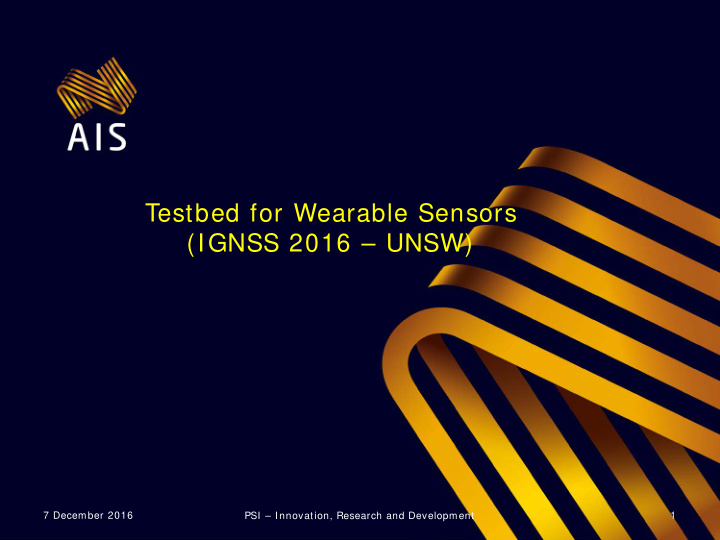



Testbed for Wearable Sensors (IGNSS 2016 – UNSW) 7 December 2016 PSI – I nnovation, Research and Development 1
Overview • Who/ what is the AIS • Approach to research • Our measurement interests • Sensor challenges 7 December 2016 PSI – I nnovation, Research and Development 2
• Established in 1980 www.ausport.gov.au • Australian Sports Commission Act of 1989: – To initiate, encourage and facilitate research and development in relation to sport; – To undertake research and development in related to sports science and sports medicine • 8 sports science and sports medicine disciplines 7 December 2016 PSI – I nnovation, Research and Development 3
Innovation Research & Development Sports Sports Medicine Nutrition Physical Physiology Therapies Movement Performance Science Psychology Strength & Conditioning 7 December 2016 4
Research at the AIS • It is a collaborative venture • Cohort of approximately 25 Post Doc and 25 PhD scholar researchers • Currently involved in 2 ARC linkage grants • Partnership agreements with 3 universities (Deakin University, Victoria University, University of Canberra) • Industry collaboration 7 December 2016 PSI – I nnovation, Research and Development 5
AIS R&D Funding $400K $550K $250K CIF P/Ships HPSRF 7 December 2016 PSI – I nnovation, Research and Development 6
Typical measurements made at AIS Blood work Physiological Biomechanical GNSS Precise Location Haemacrits Acceleration Acceleration (one limb relative (+/-10cm) to another) Lactate EMG Acceleration Joint forces (inferred indirectly from other measurements) Sugar EEG Velocity profiling Oxygen ECG Impact forces Distance travelled (measured directly using force plates) Cortisol Core temperature Route travelled Applied And the list goes on Heart rate Performance analysis 7 December 2016 PSI – I nnovation, Research and Development 7
https://people.rit.edu 7 December 2016 PSI – I nnovation, Research and Development 8
The myth of the origins of milk a.k.a (GPS) 7 December 2016 PSI – I nnovation, Research and Development 9
GPS Wearables: Challenges • Is it working? • What are the error bounds? • Low sampling rates (1 – 10 Hz)! • Impact of environment on accuracy • Typically using consumer grade GPS chipsets 7 December 2016 10 PSI – I nnovation, Research and Development
The Choice Magazine of Wearables: STEP 1 (GNSS – end of 2017) • Ability to create repeatable test scenarios • A tool for the sports scientist • Ability to advise sports scientists, coaches and athletes • Education • Precision GPS research (partnerships required) 7 December 2016 PSI – I nnovation, Research and Development 11
The Choice Magazine of Wearables: STEP 2 (Inertial – end of 2018) • Ability to create repeatable test scenarios • A tool for the sports scientist (?) • Ability to validate inertial sensor specifications 12 7 December 2016 PSI – I nnovation, Research and Development
The Choice Magazine of Wearables: STEP 3 (other – 2018 onwards) • Heart rate • Temperature • Altitude (pressure) • Electromyography • Blood oxygen saturation • and … 7 December 2016 PSI – I nnovation, Research and Development 13
Thank you for your attention. 7 December 2016 PSI – I nnovation, Research and Development 14
Recommend
More recommend